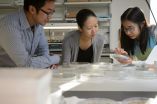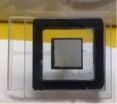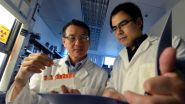(Press-News.org) The application of a new, precise way to turn genes on and off within cells, described online October 9, 2014 in two articles in the journal Cell, is likely to lead to a better understanding of diseases and possibly to new therapies, according to UC San Francisco scientists.
The key to the advance is a new invention, called the SunTag, a series of molecular hooks for hanging multiple copies of biologically active molecules onto a single protein scaffold used to target genes or other molecules. Compared to molecules assembled without these hooks, those incorporating the SunTag can greatly amplify biological activity.
The SunTag was developed by researchers in the lab of Ron Vale, PhD, a professor of molecular and cellular pharmacology and a HHMI investigator at UCSF. Vale received the Albert Lasker Basic Medical Research Award in 2012 for his discovery of molecular motors that ferry cargo around within cells.
The Vale team used the SunTag to greatly amplify the light-emitting signal from the green fluorescent protein commonly used by researchers to label molecules within cells. Viewed through a microscope, the signal that can be obtained with the SunTag is so strong it can be used to track a single molecule within the molecular motors that Vale studies.
In collaboration with Jonathan Weissman, PhD, professor of cellular and molecular pharmacology and a Howard Hughes Medical Institute (HHMI) investigator at UCSF, UCSF researchers also used the SunTag to supercharge a variation of a biochemical approach known as CRISPR.
CRISPR is a technique that emerged a few years ago as a way to edit DNA anywhere within the genome. The UCSF researchers instead adapted CRISPR to precisely dial the activity of genes up or down in a reversible way without altering DNA – a capability that might make previous methods for probing poorly understood cellular functions obsolete, they said.
"With these techniques we can fine-tune the activity of genes within cells, and this has broad implications for the reprogramming of cells," Weissman said.
Researchers at UCSF and elsewhere have previously reported ways to switch genes off and on with CRISPR, but especially for switching genes on, the previously reported methods were inefficient, according to Vale.
"It depends on the gene, but this new approach appears to amplify gene-switching by as much as 50-fold," Vale said. "It's a much more robust way of activating genes."
CRISPR with SunTag Already Is Shedding Light on Cancer and Normal Development
CRISPR – an acronym for "clustered regularly interspaced short palindromic repeats" – is a natural system that bacteria use to defend themselves against viruses. The basis for CRISPR applications in the lab is a protein from this system, called Cas9, a chassis into which researchers can insert any specific RNA partner molecule. The selected RNA serves as an adaptor that determines the target anywhere within the genome. The UCSF researchers attached the SunTag to this chassis, enabling one Cas9 to recruit many copies of potentially any protein to a specific DNA sequence.
The Weissman team led experiments demonstrating that CRISPR molecules incorporating the SunTag can be used to precisely control gene expression of many genes within the genome. They used this strategy to identify genes that prevent cancer cell growth and genes that regulate tissue development, and to gain new insight on how bacterial toxins harm cells.
The researchers refer to their CRISPR techniques for dialing down genes as CRISPR interference, and to their techniques for dialing up genes as CRISPR activation.
CRISPR activation and interference can be used to understand how specific genes work in cancer, regenerative medicine or neurodegenerative disease, according to Weissman. For instance, these methods could be used to identify biochemical pathways that cancer cells may use to develop drug resistance, and the same approach could be used to eventually develop new stem cell strategies for generating tissue transplants, he said.
Will RNA Interference Become Obsolete?
CRISPR interference differs from RNA interference, an already popular strategy for turning off protein production.
CRISPR interference has the potential to render RNA interference obsolete, according to Weissman. Unlike conventional RNA interference techniques, CRISPR interference allows any number of individual genes to be silenced at the same time. In addition, there is little risk of turning off untargeted genes the way RNA interference techniques do.
RNA interference was identified more than a decade ago, launching a new research field that has spawned a Nobel Prize and new biotech firms. RNA interference blocks the messenger RNA that drives protein protection based on the blueprint contained within a gene's DNA sequence. By preventing protein production, RNA interference may be used to get around the problem of difficult-to-target proteins, a frequent challenge in drug development.
But CRISPR interference acts one step earlier in the cell's protein manufacturing process.
"The horse has already left the barn with RNA interference, in the sense that the RNA message already has been transcribed from DNA," Weissman said. "With CRISPR interference, we can prevent the message from being written."
CRISPR activation of genes can provide complementary biological insights. The adaptation of the SunTag for CRISPR activation makes it possible to systematically probe the biological roles of all genes within the genome in a single experiment.The Weissman team used CRISPR activation to identify a number of tumor suppressor genes that inhibit the growth of cancer cells. In future studies, researchers will use CRISPR activation to reveal mechanisms by which cancer cells develop resistance to anti-cancer drugs – a process that typically involves gene activation.
INFORMATION:
The National Institutes of Health and the Howard Hughes Medical Institutes provided major support for the studies.
UCSF is the nation's leading university exclusively focused on health. Now celebrating the 150th anniversary of its founding as a medical college, UCSF is dedicated to transforming health worldwide through advanced biomedical research, graduate-level education in the life sciences and health professions, and excellence in patient care. It includes top-ranked graduate schools of dentistry, medicine, nursing and pharmacy; a graduate division with world-renowned programs in the biological sciences, a preeminent biomedical research enterprise and top-tier hospitals, UCSF Medical Center and UCSF Benioff Children's Hospitals. Please visit http://www.ucsf.edu.
Precise control over genes results from game-changing research
UCSF invention greatly amplifies power of CRISPR technology
2014-10-14
ELSE PRESS RELEASES FROM THIS DATE:
Discovery of cellular snooze button advances cancer and biofuel research
2014-10-14
EAST LANSING, Mich. – The discovery of a cellular snooze button has allowed a team of Michigan State University scientists to potentially improve biofuel production and offer insight on the early stages of cancer.
The discovery that the protein CHT7 is a likely repressor of cellular quiescence, or resting state, is published in the current issue of the Proceedings of the National Academy of Sciences. This cellular switch, which influences algae's growth and oil production, also wields control of cellular growth – and tumor growth – in humans.
Christoph ...
Sustained feedback to doctors may help maintain appropriate antibiotic usage in children
2014-10-14
A program that provides guidance to primary care physicians about appropriately prescribing antibiotics for children is effective, but its improvements wear off after regular auditing and feedback are discontinued.
"Our findings suggest that interventions with outpatient healthcare providers should include continued feedback to clinicians to remain effective," said study leader Jeffrey S. Gerber, M.D., Ph.D., an infectious diseases specialist at The Children's Hospital of Philadelphia (CHOP).
Gerber and colleagues from CHOP published their research online Oct. 10 in ...
Earliest-known lamprey larva fossils unearthed in Inner Mongolia
2014-10-14
LAWRENCE — Few people devote time to pondering the ancient origins of the eel-like lamprey, yet the evolutionary saga of the bloodsucker holds essential clues to the biological roots of humanity.
Today, the Proceedings of the National Academy of Sciences published a description of fossilized lamprey larvae that date back to the Lower Cretaceous — at least 65 million years ago.
They're the oldest identified fossils displaying the creature in stages of pre-metamorphosis and metamorphosis.
"Among animals with backbones, everything, including us, evolved from ...
Stress may be harder on women's hearts than men's
2014-10-14
DURHAM, N.C. -- Researchers have known for decades that stress contributes to heart disease. But a new analysis by researchers at Duke Medicine shows mental stress may tax women's hearts more than men's.
The research appears online Oct. 13, 2014, in the Journal of the American College of Cardiology.
"Normally when under stress, we fight back or run away. In order to do that, we need to pump more blood to the body," said Wei Jiang, M.D., the study's senior author and professor of medicine, psychiatry and behavioral sciences at the Duke University School of Medicine. ...
Beyond LEDs: Brighter, new energy-saving flat panel lights based on carbon nanotubes
2014-10-14
Washington D.C., October 14, 2014 -- Even as the 2014 Nobel Prize in Physics has enshrined light emitting diodes (LEDs) as the single most significant and disruptive energy-efficient lighting solution of today, scientists around the world continue unabated to search for the even-better-bulbs of tomorrow.
Enter carbon electronics.
Electronics based on carbon, especially carbon nanotubes (CNTs), are emerging as successors to silicon for making semiconductor materials. And they may enable a new generation of brighter, low-power, low-cost lighting devices that could challenge ...
Rats of New York and the diseases they carry
2014-10-14
In the first study to look at would-be diseases carried by New York City rats, scientists at the Center for Infection and Immunity at Columbia University's Mailman School of Public Health identified bacterial pathogens, including E. coli, Salmonella, and C. difficile, that cause mild to life-threatening gastroenteritis in people; Seoul hantavirus, which causes Ebola-like hemorrhagic fever and kidney failure in humans; and the closest relative to human hepatitis C. Results appear in the journal mBio.
The researchers trapped 133 Norway rats at 5 sites in New York City, ...
'Grapes of Wrath': Stomping out grape disease one vineyard at a time
2014-10-14
Cracking the genetic code of a common disease affecting grape production could improve vineyard management and help protect the multibillion-dollar industry that includes raisins, juice, jam/jelly, fresh grapes, grape-seed extract and oil, vinegar and wine.
A Rochester Institute of Technology scientist and an RIT alumnus are close to completing the genetic blueprint, or microbiome, of grape crown gall tumor disease—the bane of vineyards worldwide. Their study focuses on 16 grape varieties, including Cabernet Sauvignon and Riesling, from vineyards in the New York ...
Brand loyalty: What happens when our favorite products are unavailable?
2014-10-14
What would happen to all those millions of Snickers fans if their favorite chocolate bar was temporarily out of stock? Would they wait for it to be available again or would they quickly switch allegiance to Milky Way or Kit Kat? According to a new study in the Journal of Consumer Research, when you can't get your favorite product, you'll quickly forget about it if you can find a good replacement.
"We studied situations in which products are temporarily unavailable. We found that desire for a product depends on the amount of time that has passed since a consumer was able ...
New treatment target identified for aggressive breast cancer
2014-10-14
AUGUSTA, Ga. – One of the first-known oncogenes has a protein partner that helps breast cancer proliferate and when it's blocked, so is the cancer, scientists report.
The gene ErbB2, commonly called HER2, is highly expressed in about 25 percent of breast cancers. Scientists have now found the protein Erbin, thought to be an anti-tumor factor, also is highly expressed in these cancers and essential to ErbB2's support of breast cancer.
When scientists interfere with the interaction between the two in mice, it inhibits tumor development and the usual spread to the ...
Forced to be bad: When eating that chocolate cake is 'not our fault'?
2014-10-14
Imagine you're dining out with a friend who insists on sharing some chocolate cake for dessert. Since the decision has already been made for you, you gladly join in without feeling any regret. According to a new study in the Journal of Consumer Research, consumers are happier when someone else decides they can indulge in dessert or other guilty pleasures.
"Most of us don't like being forced to do things. The freedom to make our own decisions generally energizes us and increases our sense of well-being. However, when it comes to purchasing and consuming products normally ...
LAST 30 PRESS RELEASES:
Injectable breast ‘implant’ offers alternative to traditional surgeries
Neuroscientists devise formulas to measure multilingualism
New prostate cancer trial seeks to reduce toxicity without sacrificing efficacy
Geometry shapes life
A CRISPR screen reveals many previously unrecognized genes required for brain development and a new neurodevelopmental disorder
Hot flush treatment has anti-breast cancer activity, study finds
Securing AI systems against growing cybersecurity threats
Longest observation of an active solar region
Why nail-biting, procrastination and other self-sabotaging behaviors are rooted in survival instincts
Regional variations in mechanical properties of porcine leptomeninges
Artificial empathy in therapy and healthcare: advancements in interpersonal interaction technologies
Why some brains switch gears more efficiently than others
UVA’s Jundong Li wins ICDM’S 2025 Tao Li Award for data mining, machine learning
UVA’s low-power, high-performance computer power player Mircea Stan earns National Academy of Inventors fellowship
Not playing by the rules: USU researcher explores filamentous algae dynamics in rivers
Do our body clocks influence our risk of dementia?
Anthropologists offer new evidence of bipedalism in long-debated fossil discovery
Safer receipt paper from wood
Dosage-sensitive genes suggest no whole-genome duplications in ancestral angiosperm
First ancient human herpesvirus genomes document their deep history with humans
Why Some Bacteria Survive Antibiotics and How to Stop Them - New study reveals that bacteria can survive antibiotic treatment through two fundamentally different “shutdown modes”
UCLA study links scar healing to dangerous placenta condition
CHANGE-seq-BE finds off-target changes in the genome from base editors
The Journal of Nuclear Medicine Ahead-of-Print Tip Sheet: January 2, 2026
Delayed or absent first dose of measles, mumps, and rubella vaccination
Trends in US preterm birth rates by household income and race and ethnicity
Study identifies potential biomarker linked to progression and brain inflammation in multiple sclerosis
Many mothers in Norway do not show up for postnatal check-ups
Researchers want to find out why quick clay is so unstable
Superradiant spins show teamwork at the quantum scale
[Press-News.org] Precise control over genes results from game-changing researchUCSF invention greatly amplifies power of CRISPR technology





